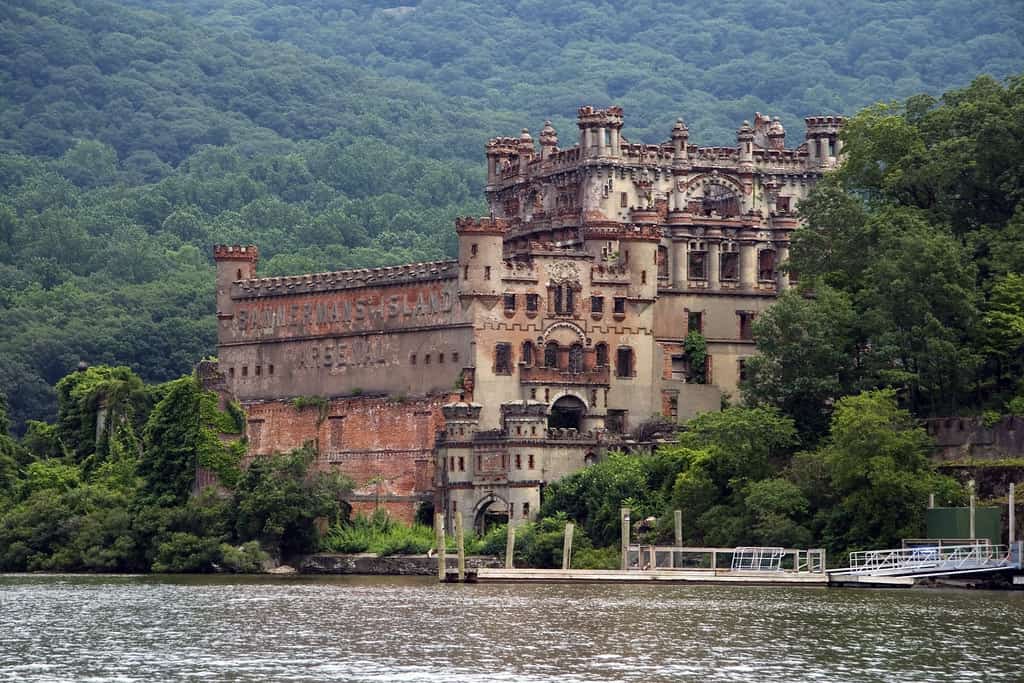Marketed Ruin — Bannerman Castle’s Shelf Appeal
The shell of a castle sits just off the Hudson River, half a mile from the eastern shore. From the Metro-North train, it appears suddenly—stone walls, empty windows, a broken turret.
The side facing Beacon still reads “Bannerman’s Island Arsenal,” cast in thick concrete more than a century ago. It was meant to advertise.
Today, it looks abandoned. But in the early 1900s, this six-and-a-half-acre island was part of a military surplus empire.
Pollepel Island—sometimes spelled Pollopel—became a warehouse turned billboard for Bannerman’s catalog business, which once spanned 300 illustrated pages and sold everything from uniforms to decommissioned cannons.
The New York State Office of Parks, Recreation, and Historic Preservation now owns the castle.
It passed into their hands in 1967 after the state’s purchase cleared the remaining inventory and transferred relics to the Smithsonian.
For decades, the structure decayed without maintenance. The ferry that once linked it to shore—the Pollepel—sank in a 1950 storm. In 1969, a fire gutted the main floors and roofs, and access was cut off.
That changed in 2004. Bannerman Castle Trust, a nonprofit with volunteers and private donors, started offering guided tours of the island.
The trust handles basic upkeep, though the site remains vulnerable. Vandalism and weather have taken their toll.
In late December 2009, about 40% of the front wall collapsed, and half of the eastern façade came down with it.
Despite that, tourists come. The ruins are visible from Amtrak’s Empire Corridor and the northbound lanes of Route 9D.
Day-trippers from across the region list it among the top things to do north of New York.
But visitors don’t walk in alone—bulkheads and old causeways sink below high tide, creating hazards under the waterline.
Bannerman’s name still floats in the air. But the fortress, once built to sell, now struggles to stand.

Pre-Sale Inventory — The Island Before the Brand
Pollepel Island came into view long before the word “Bannerman” ever did.
In the 1600s, Dutch settlers gave it a name that meant “ladle,” maybe because of its curved shape or the way it dips into the Hudson.
There was nothing to sell back then—just rock, trees, and a view across to Plum Point.
By 1777, the island was between British warships and upriver towns.
American revolutionaries tried to block passage using a chain of chevaux de frise—timber frames with iron-tipped spikes—anchored between Pollepel and the opposite shore.
It didn’t work, and British troops burned Kingston anyway. The caissons used in that blockade still rest at the bottom of the river, rusted and half-buried.
A few years later, the U.S. Army floated a proposal to build a military prison on the island.
General Washington approved it. But the prison never appeared, and neither did permanent residents.
There were no shipping yards, housing, or infrastructure, and the island remained empty for more than a century.
The terrain made it a tough sell: rough stone, uneven elevation, and only reachable by boat.
Real estate agents didn’t have it on their maps. Before the 20th century, Pollepel was mostly a blank—visited by fishermen, rumored to be haunted, and forgotten when the fog rolled in.
Anyone could land there. The shoreline was rocky but open. By the late 1800s, a few downriver residents took weekend trips to explore the brush and climb the natural rise in the center.
There were no fences, guards, or posted signs. It was just a stretch of wilderness 50 miles north of New York City.
What it lacked in livability was that it offered in isolation. When it finally did sell—in November 1900—the buyer didn’t want a home. He needed space for thirty million rounds of surplus ammunition.
Arms & Architecture — The Business of Bannerman’s Arsenal
The deal closed in late 1900. Francis Bannerman VI bought the island from the Taft family for an undisclosed amount.
A year later, construction started. He didn’t hire architects in the usual sense—he sketched ideas and let builders figure out the rest.
Some towers went up straight. Others leaned from the beginning.
His company, Bannerman’s, had grown fast. It began in Brooklyn in 1865 with scrap rope and chandlery sales near the Navy Yard.
After the Civil War, surplus markets opened up. By 1897, Bannerman’s had a storefront on Broadway and a booming catalog business.
When the U.S. defeated Spain in 1898, the company bought 90% of the confiscated Spanish weapons at auction.
That created a storage problem. Bannerman’s Manhattan space—located near 501 Broadway—wasn’t equipped to hold cases of explosives.
By spring 1901, workers hauled crates of cartridges, rifles, and field gear upriver.
The island became a depot and display at the same time.
Bannerman added flair. Decorative cannons lined the grounds, and a smaller castle near the top of the island served as his seasonal residence.
Pieces from the warehouse inventory—helmets, bayonets, shields—were cemented into the walls.
The message was clear: this was a fortress, and everything inside was for sale.
The company continued to buy big. Around 1908, the Navy rearmed older ships. Bannerman purchased the discarded 6-inch naval guns.
When the U.S. entered World War I in 1917, he sold thirty of them back to the Army.

Liability and Loss — When the Inventory Turned
Construction stopped in 1918. Bannerman died that year, and with him went the vision that built the island.
The business limped on, but the industry had started to change. New York State passed laws tightening access to military-grade weapons.
Congress followed. Selling guns to civilians became harder—and riskier.
Then came the accident. In August 1920, an explosion tore through one of the side buildings. Two hundred pounds of black powder and shells ignited without warning.
No official cause was released, and damage estimates were never made public, but parts of the arsenal’s walls collapsed.
Some sections were never rebuilt.
Sales declined. Bannerman’s catalog still went out in the 1920s, though smaller and thinner each year.
Inventory aged on the shelves. Most of it sat untouched—old rifles, field gear, and surplus ammunition now decades out of date.
The island grew quiet. In 1950, the Pollepel ferry sank during a storm. The boat had been the only regular transport to the island.
Without it, moving stock or people was difficult. Tours and maintenance stopped. Vandals came first, then the weather.
In 1967, New York State bought the island. The deal included the condition that all remaining military equipment be cleared before transfer.
Some pieces went to the Smithsonian, and others were scrapped. A year later, the state briefly opened the island for tours.
On August 8, 1969, a fire swept through the main structure, taking the roofs and floors.
The blaze burned for hours. By morning, the interiors were gone. Walls stood empty, windows scorched, and signs blackened. After that, the island was closed to the public.
What remained was listed on the National Register of Historic Places in 1982, more as an artifact than an asset.
Keeping the Ruins in View
By the early 2000s, the castle had become a landmark by default. Tourists spotted it from the train, and kayakers circled it in warm months.
The state hadn’t restored it—but it hadn’t torn it down either. That gap left room for something else.
In 2004, the Bannerman Castle Trust began offering on-site tours. The nonprofit operated through donations, grants, and seasonal ticket sales.
Staff included local volunteers and part-time guides. The goal wasn’t to rebuild the arsenal; it was to stop it from falling.
Still, parts did fall. In the last week of December 2009, a driver on Route 9D reported new damage.
Officials from Metro-North confirmed it—30 to 40 percent of the front façade and half the eastern wall had collapsed.
Engineers blamed water damage, freeze-thaw cycles, and gravity. No repairs were scheduled.
Then came a new interest. In June 2015, Beacon-based artist Melissa McGill launched “Constellation”—a public art piece that used seventeen LED-tipped poles mounted on and around the ruins.
The lights activated for two hours each night, mimicking stars. It lasted through 2017.
That same year, another story made headlines. In April 2015, a man drowned near the island during a kayak trip.
His fiancée was later charged and pled guilty to criminally negligent homicide. It wasn’t the kind of attention the Bannerman Castle wanted.
But it reminded the public: the island was still there.
Bannerman Castle, with archival photos, came out in 2006. Later, a children’s story, My Name is Eleanor, was published based on accounts from the family of a caretaker who lived there in the early 1900s.
Other titles, including The Devils That Haunt You and Adventures of a Cat-Whiskered Girl, used the island as a backdrop.
As of 2025, the tours still run. Access is limited, and preservation is ongoing—mostly weather-dependent. Bannerman Castle remains in ruins, but it’s open. The tickets sell out fast.

















